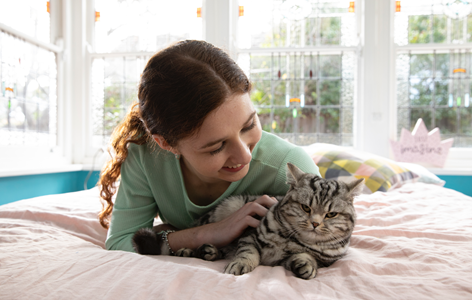We all know the old saying that dogs have masters, and cats have slaves. But with the right approach, even a cat can be trained.
Most dogs are highly trainable and enjoy the experience. They will sit, stand, come, fetch and so on for a pat or a treat, but did you know that you can also train your cat?
One of the well-known facts about cats is that cats are highly intelligent animals, and they respond well to training as it gives them mental and physical stimulation. Keeping your cat’s mind active is really important, as bored cats are prone to overeating and oversleeping, and are more likely to develop stress disorders. Denise, a veterinary nurse, has successfully trained her cat, Maggie, to take a pill twice a day. “Maggie hated taking her medication, and at first I had to restrain her. She would immediately run away from me, and this wasn’t good for our relationship. I needed an effective solution, so I decided to make pill time a positive addition to our daily routine.”
Denise’s advice is to complete training in small stages, ensuring you get one behaviour right before moving on to the next. “The first stages were surprisingly quick – each took about a week to perfect. Although there were some frustrating days, it was also really fun and an enjoyable enrichment activity,” says Denise.
Cats can be trained to carry out a variety of actions, ranging from the fun – high-fives and fetching – to the useful, such as sitting, coming when called, and even taking pills, as Denise and Maggie have proved. If you’re ready to give it a go, you need to arm yourself with some healthy treats and a fair bit of patience!
Some handy hints for successful cat training:
Understand your cat
Look, it's no secret that you need a lot more than just the right litter and cat litter tray to be a good cat parent. Cats are not as social as dogs, and therefore don’t respond to training techniques in the same way. Whereas dogs want to please you, and respond to praise and attention, cats are motivated by what pleases them – not what pleases you! Watch your cats' behaviour very closely and soon the question "why do cats meow" won't be an impossible one anymore. Cats are persuaded by food, so make sure you choose appropriate (but certainly irresistible!) treats to use during your training sessions. Be sure to select treats that are low in fat and salt, as you may have to use quite a few of them during your training period. Or follow Denise’s lead – she gave Maggie her food immediately after administering her medication. “I put Maggie’s food on the floor as soon as I released her, and it only took her a few days to link it with receiving dinner.”
Avoid punishment
Keep in mind that cats respond poorly to punishment. Rather than learning not to produce certain behaviour, cats will just learn to be afraid of you, and will run away. If your cat has a sensitive temperament, she may even hide and exhibit symptoms of stress and anxiety, such as excessive grooming and urinating inappropriately. The best time to train your cat is just before she eats. Ensure her meal times are set, and she is not allowed to ‘graze’ throughout the day. This way, she will be more motivated and open to training, as she is feeling hungry. Plan for two or three short training sessions per day, limited to five minutes at a time. Cats respond well to training conducted in short, focused bursts.
Reward immediately
Timing is everything. Cats have short attention spans so you must reward your cat immediately – within seconds of witnessing the behaviour – or she might not make the connection between producing the behaviour and receiving a treat. She might not understand what she is being rewarded for, and this can make your job a lot harder. “The second you see the behaviour you want, reward or move on to the next behaviour in the sequence,” says Denise.
Reward consistently
It is really important to ensure you reward your cat every time she produces the desired behaviour. Make sure everyone in your household is aware of the behaviour you are trying to train, so they can offer your cat a treat when they see her complete the behaviour. Denise warns, “Be careful not to reward the wrong behaviour. If your cat doesn’t produce the behaviour you want, stop and wait until she does what you want. It may take longer at the beginning, but it saves lots of time in the end.”











